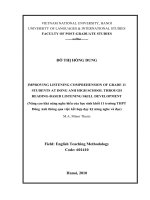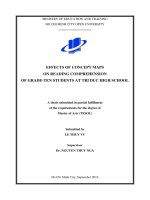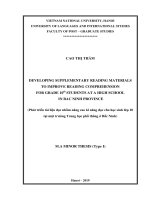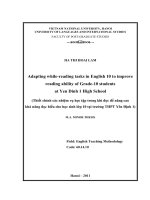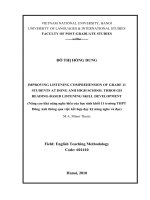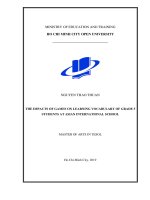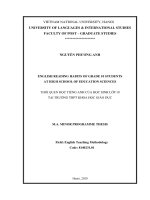Khóa luận Difficulties in reading comprehension of grade 10 students at Asian International Highschool
Bạn đang xem bản rút gọn của tài liệu. Xem và tải ngay bản đầy đủ của tài liệu tại đây (724.09 KB, 63 trang )
Hochiminh City
……………………………………..
GRADUATION THESIS
Major
English Language
Topic
DIFFICULTIES IN READING
COMPREHENSION OF GRADE
10 STUDENTS AT ASIAN
INTERNATIONAL
HIGHSCHOOL
Instructor
Nguyen Thanh Tuan,MA
Student
Luu Khanh Quyen
ID: 97011501055
i
DECLARATION
The thesis entitled “Difficulties in reading comprehension of grade 10 at the Asian
International Highschool” is conducted under the supervision of M.A . Nguyen Thanh Tuan
an instructor of English at English Department, Saigon International University.
I declare that the information reported in the current paper is a result of my own work, except
where due to reference is made. The thesis has not been accepted for any degree and is not
concurrently submitted to any candidature for any other degree or diploma.
Ho Chi Minh, .
Signature
ii
ACKNOWLEDGEMENT
During the process of doing this study, I have received useful help from my teachers, my
family, my friends.
First of all, I would like to express my deep gratitude to my instructor Mr. Nguyen Thanh
Tuan who has help me much in choosing the title of this study and giving me valuable
suggestion as well as guidance so that I can fulfill this graduation thesis paper. He gave me
encouragement at all the stages of completing my study. During the process of my research, I
am not only instructed carefully by him, but also learn many valuable things from method of
doing research, the way to consider and solve problem independently. Without his guidance,
help and support, I would not have completed my study.
Beside the support of Mr. Nguyen Thanh Tuan, I am very grateful to my parents for their
metal support and encouragement. They are the biggest motivation for me to overcome all
the difficulties to completing the study. In addition, I would like to say “Thank you” to my
friends, thank you for their support and being side by side with me.
I am really in debt to my family and my friends for their all usefull help and great
encouragement during the time I has done this paper.
iii
INTRUCTOR’S COMMENTS
……………………………………………………………………………………………
…………………………………………………………………………………………………
…………………………………………………………………………………………………
…………………………………………………………………………………………………
…………………………………………………………………………………………………
…………………………………………………………………………………………………
…………………………………………………………………………………………………
…………………………………………………………………………………………………
…………………………………………………………………………………………………
…………………………………………………………………………………………………
…………………………………………………………………………………………………
…………………………………………………………………………………………………
…………………………………………………………………………………………………
…………………………………………………………………………………………………
…………………………………………………………………………………………………
…………………………………………………………………………………………………
…………………………………………………………………………………………………
…………………………………………………………………………………………………
…………………………………………………………………………………………………
…………………………………………………………………………………………………
.................., Date............. Month........... Year...............
Mark: ……………………………………
Sign: ………………………………………
iv
ABSTRACT
The reading comprehension skill is considered as one of the four fundamental language skills
that an EFL learner must perform. Actually, it is not an easy skill since most of learners have
many reading issues. The purpose of this present work is to investigate on these reading
difficulties that grade 10 students at the Asian International Highschool face, and to identify
their reading problems and the reasons behind their weaknesses in performing the reading
task. The questionnaire and interview have been used as research instruments which are
addressed, respectively, to third-year learners and teachers at Asian International highschool.
The results reveal that most of the learners have difficulties in reading comprehension at the
level of ambiguous words, reading strategies, as well as the nature of the selected materials.
v
TABLE OF CONTENT
DECLARATION……………………………………………………………………………..i
ACKNOWLEDGEMENT…………………………………………………………………..ii
SUPVERISOR’S COMMENT……………………………………………………………..iii
ABSTRACT………………………………………………………………………………….iv
CHAPTER 1: INTRODUCTION AND CONTENT OF THE THESIS………………….1
1.1 Statement of problem……………………………………………………………………...1
1.2 The significance of the study………………………………………………………………
2
1.3 Scope of the study…………………………………………………………………………2
CHAPTER 2: LITERATURE REVIEW……………………………………………………
4
2.1
Definition
of
key-terms
…………………………………………………………...
…….....4
2.1.1 What is reading? ……………………………………………………………………….4
2.1.2 Comprehension ……………………………………………………..............................6
2.1.3 Reading comprehension………………………………………………………………..6
2.1.4 Types of reading comprehension……………………………………………………....6
2.1.4.1 Oral reading …………………………………………………………………….…6
vi
2.1.4.2 Silent reading ……………………………………………………………………...6
2.1.4.3 Intensive reading…………………………………………………………………..7
2.1.4.4 Extensive reading ………………………………………………………………...7
2.1.5 Skills of reading comprehension……………………………………………………...9
2.1.5.1 Scanning…………………………………………………………………………..9
2.1.6.2 Skimming………………………………………………………………………..10
2.1.6 Difficulties ……………………………………………………………………………11
2.1.6.1 Difficulty in understanding long sentence………………………………………...12
2.1.6.2 Difficulty in using reading strategies………………………………………………13
2.1.6.3 Losing your place………………………………………………………………….13
2.1.6.4 Losing your focus………………………………………………………………….13
2.1.6.5 Not getting the point ………………………………………………………………13
2.1.6.6 Forgetting what you have read…………………………………………………….13
2.1.7 Solutions……………………………………………………………………………...14
. 2.1.8 Strategies for reading comprehension …………………………………………….…15
2.1.8.1 Strategies for Reading Comprehension: Narrative Text…………………………..17
2.1.8.2 Strategies for Reading Comprehension: Expository Text…………………………19
2.1.9 Method in teaching reading…………………………………………………………..21
vii
2.2 Preview previous work ………………………………………………………………….22
CHAPTER 3: METHODOLOGY………………………………………………………...24
3.1 Research method………………………………………………………………………...24
3.2 Research questions………………………………………………………………………25
3.3 Description………………………………………………………………………………25
3.4 Participants……………………………………………………………………………....26
3.5 Tools to collect data……………………………………………………………………..26
3.6 Procedure………………………………………………………………………………...27
CHAPTER 4: FINDING AND DISCUSSION……………………………………………28
4.1 Data analysis……………………………………………………………………………..28
4.1.1 Opinions about reading materials…………………………………………………….29
4.1.2 The purpose of reading…………………………………………………………….....30
4.1.3 Opinions about the effective and essential of reading strategies……………………..31
4.1.4 Difficulties and time sufficiency……………………………………………………..33
4.1.5 Students’ strategies…………………………………………………………………...36
4.1.6 The essential of vocabulary and grammar……………………………………………39
4.2 Discussion of the results…………………………………………………………………42
CONCLUSION……………………………………………………………………………..45
viii
1
CHAPTER 1:
INTRODUCTION AND CONTENT OF THE THESIS
1.1 Statement of problem
Nowadays, English does not only become popular but it is also a main international
language. When you go to another country, or communicate with foreigner, you have to
understand their language but be side that you can use English to communicate with them. As
you know, today about 2/3 countries in the world use English as their mother tongue or as a
second language.
English has been taught in many general- educational schools. We know that teaching and
learning English are very important. Which are the best learning methods and strategies for
students who learn English at Asian International High school? What difficulties that
students have when they learn English ?
The Asian International School’s International English program is designed according to
American Education Reaches Out (AERO) and Common Core State Standard – United State.
The school curriculum is drafted and evaluated by the Science Council of the school.
Students of the Asian International School benefit from an advanced education program with
a diverse knowledge base.
However, not all students of the Asian International High school can keep up with the
international English program. Some students had problem with English skills in the learning
process and most students had difficulties in reading skill.
2
The biggest obstacle for grade 10 students at Asian International High school is that they
have no methods and strategies in reading comprehension. This topic is great interest in
studying it. So this is the reason make me want to find out the cause and understand more
about these to find some solutions.
1.2 The significance of the study
As above introduction, I carry out this study with the hope to find out the difficulties received
by the grade 10 students at Asian International high school in reading comprehension, the
way to improve reading comprehension, and also support students of grade 10 at the Asian
International Highschool who are learning English to pass the difficulties in reading
comprehension easily follow three steps:
Step 1 : To find out difficulties perceived by grade 10 students at Asian International High
school in reading comprehension
Step 2 : To improve the difficulties perceived by grade 10 students at Asian International
High school in reading comprehension.
Step 3 : To develop and enhance skills in reading.
1.3 Scope of the study
Nowadays, English is a language that plays an important role in learning and work. In order
to learn and use English well, leaners must grasp English skills and it takes a lot of time and
wisdom.
English as well as English skills is a very wide field of knowledge but due to the time to
complete a research is short. It is only in 2 months and personal knowledge is still limited so
3
I just emphasize English skills especially reading comprehension in Asian International
Highschool.
This study aimed at investigating the problems in English reading skill as perceived by 115
students who are learning English program at Asian International Highschool.
4
CHAPTER 2:
LITERATURE REVIEW
2.1
Definition of key-terms
2.1.1 What is reading ?
Reading is a multifaceted process involving word recognition, comprehension, fluency and
motivation. Learn how reader integrate these facets to make meaning from print ( by Diane
Henry Leipzig 2001 )
Reading is making meaning from print. It require that we :
a. Construct an understanding from them - a process called comprehension
b. Coordinate identifying words and making meaning so that reading is automatic and
accurate - an achievement called fluency.
Most of us think of reading as a simple, passive process that involves reading words in a
linear fashion and internalizing their meaning one at a time. But reading is actually a very
process that requires a great deal of active participation on the part of he reader.
To get a better sense of the complexity of reading, read what some experts in the field have
said about the reading process:
5
What do we read ? The message is not something given in advance or given at all - but
something created communicative situation. - Roy Harris in Rethinking Writing (2000:254)
Reading is asking questions of printed text. And reading with comprehension becomes a
matter of getting your questions answered. - Frank Smith in Reading With Nonsense
(1997:41)
Reading is a psycholinguistic guessing game. It involves an interaction between thought and
language. Efficient reading does not result from precise reception and identification of all
elements, but from skill in selecting the fewest, most productive cues necessary to produce
guesses which are right the first time. The ability to anticipate that which has not been seen,
of course, is vital in reading, just as the ability to anticipate what has not yet been heard is
vital in listening - Kenneth Goodman in Journal of the reading Specialist (1967:26)
Reading involves many complex skills that have to come together in order for the reader to
be successful. Proficient readers recognize the purpose for reading, approach the reading with
that purpose in mind, use strategies that have proven successful to them in the past when
reading similar texts for similar purposes, monitor their comprehension of the text in the light
of the purpose for reading. When unknown words arise and their meaning is needed for
comprehension, proficient readers have a number of word attack strategies available hat will
allow them to decipher the meaning of the words. Reading is also a complex process in that
from the text by using their own prior knowledge and experiences. Proficient readers are
constantly making predictions while reading. It is this continuous interaction with the text
that allows readers to make sense of what they are reading.
6
2.1.2 Comprehension
Hornby (2008) defines understanding as knowing the meaning of importance or cause of
something.
According to Crowell (2000), comprehension involves understanding the words on the page
together with understanding of ideas being expressed by the writer.
2.1.3 Reading comprehension
It is the process of using syntactic, semantic and rhetorical information found in printed text
to reconstruct in the reader’s mind, using the knowledge of the word he or she possesses, plus
appropriate, cognitive skills and reasoning ability (Devine:1986).
2.1.4 Types of reading comprehension
Several types of reading may occur in a language classroom. One way in which these may be
categorized, as suggested by Brown (1989:216) can be outlined as follows:
2.1.4.1
Oral Reading:
Oral reading means reading aloud. The oral translation of printed or written material, often
used as measure of a student’s overall reading performance to examine aspects of reading
accuracy, fluency.
2.1.4.2
Silent Reading:
7
Silent reading is complex set of skills. The purpose of silent reading is to enable the learners
to comprehend the meaning of what they read.
2.1.4.3
Intensive
Brown, D.S (1989) explains that intensive reading “calls attention to grammatical forms,
discourse markers, and other surface structure details for the purpose of understanding literial
meaning, implications, rhetorical relationships, and the like.
It sometimes called “Narrow Reading”, may involves students reading selections by the same
author or several texts about the same topic. The success of “Narrow reading” on improving
reading comprehension is based on the premise that the more familiar the reader is with the
test, either due to the subject matter or having reading other works by the same author, the
more comprehension is promoted.
Intensive reading is used to teach or practice specific strategies or skills. The text is treated as
an end in itself. Intensive reading on the other hand, involves reading of large quantities of
material, direct and fluently. It may include reading simply for pleasure or reading technical,
scientific or professional material.
2.1.4.4
Extensive
Brown, D.S (1989) explained that Extensive reading is carried out “to achieve a general
understanding of a text.”
8
Long and Richards (1971,p.216) identified Extensive Reading as “occurring when students
read large amounts of high interest material, usually out of class, concentrating on meaning,
“reading for gist and skipping unknown words.”.
The aims of Extensive Reading are to build reader confidence and enjoyment. Extensive
Reading is always done for the comprehension of main ideas, not for specific details.
‘Extensive reading means reading in quantity and in order to gain a general understanding of
what is read’ (Richards, 1992). Extensive reading is often reading for pleasure. With respect
to the importance of extensive reading, Grable (1995) has drawn up on the work of, among
other, Elley (1991); Krashen (1989, 1993); Stanovich and Cunningham (1993) that extensive
reading can or may contribute to effective reading. According to Grable (1995), extensive
reading helps develop ability in word recognition both in quantity and quality. The more
extensively students read, the larger and more automatic recognition vocabulary students will
gain.
2.1.5 Skills of reading comprehension
As in all reading comprehension exercises, a variety of skills are required to deduce the right
answer. These include skimming, scanning, paraphrasing, and understanding vocabulary in
context. You must be able to identify synonyms and implied information. A clue is that the
order of the questions follows the order to the information in the reading passage. This
should save time when scanning for specific details. Make sure the answer you choose
answers the question, as many of the answer choices may simply repeat information in the
9
reading passage. Lastly, you might prefer reading the questions before skimming the
passage, to give you a better idea of what's to come.- by Catherine Snow (2012:10)
2.1.5.1
Scanning
Scanning is a skill that requires that you read quickly while looking for specific information.
Scanning is used when a specific piece of information is required, such as a name, date,
symbol, formula, or phrase, is required. The reader knows what the item looks like and so,
knows when he has located what he was searching for. It is assumed then, that very little
information is processed into long-term memory or even for immediate understanding
because the objective is simply matching.
Generally, scanning is a technique that is helpful when you are looking for the answer to a
known question.
When it is used ?
Scanning is used often with technical, scientific or professional materials to locate specific
information.
Scanning is a valuable skill for second language learners to develop because often they do
not require a detailed read of a text. There are many everyday uses for scanning, relevant to a
purpose, such as reading a schedule.
10
Activities
Learners use skills of prediction and anticipation. They may make predictions and guesses or
use titles and tables of contents to get an idea of what a passage is about
activate prior knowledge about the topic of the passage by answering some questions or
performing a quiz. Besides that, use keywords is also very important in reading
comprehension.
It is an accepted view today that efficient readers are not passive. They react with a text by
having expectations and ideas about the purposes of the text as well as possible outcomes.
They reflect on expectations as they read, anticipate what will come next. In other words, they
"interact with the text".
2.1.5.2
Skimming
Skimming is the most rudimentary type of reading. Its object is to familiarize you as quickly
as possible with the material to be read.
Skimming is a quick reading to get the general meaning of the passage, how the passage is
organized, that is the structure of the text and to get an idea of the intention of the writer.
Skimming is a more complex task than scanning because it requires the reader to organize
and remember some of the information given by the author, not just to locate it. It is a tool in
which the author's sequence can be observed, unlike scanning in which some predetermined
information is sought after.
11
When it is used ?
Skimming is used as part of the SQ3R method of reading, often for speed reading. This
method involves the student in surveying, questioning, reading, reviewing and reciting.
Skimming is used for the initial survey and for review. It is used in making decisions on how
to approach a text such as when determining if a careful reading and deserving.
By determining text, learners able to understand that it is possible to gaining meaning
without reading every word in a text.
Activities
Leaners must locate facts that are expressed in sentences, not single words. Leaners should
read rapidly, to form appropriate questions and predictions and then read quickly.
Pugh (1978) suggests that to assess skimming, after the students have read and completed the
assigned questions, further questions may be asked, "beyond the scope of the purpose
originally set" (p.70). If students can answer these questions correctly, it indicates they have
read the text too closely.
2.1.6 Difficulties
Difficulty is something that complicated to do (Richard 2007). It will be seen from students’
mistake or error learning process. In fact, many senior high school students often find the
difficulties in reading comprehension. These difficulties result the student’s poor
performance in reading test. Thus, from these factors arise some difficulties in reading
comprehension.
12
There are some internal factors that influence the students in reading comprehension that are
generally found by the reader during reading, namely; difficulty in understanding long
sentence and text, difficulty that is caused by limited background knowledge, difficulty in
using reading strategies and difficulty in concentration (Fajar: 2009).
2.1.6.1
Difficulty in understanding long sentence
In a common problem that most of students finds difficulty in understanding the long
sentence with complicated structure. It is supported by report of Barfield (1999 as cited by
Fajar 2009) that shows almost 12 percent of students had difficulty in understanding long
sentences in graded story and 20 percent in academic text. Therefore, the effect of this
problem is the students who cannot comprehending long sentence they fail to understand the
main idea presented in the text.
2.1.6.2 Difficulty in Using Reading Strategies
The students who lack of reading strategies often fails in understanding the text. The students
who are not familiar with reading strategies such as skimming and scanning will feel down
and frustrated because they lack of tool necessary to succeed in reading comprehension test
(Duarte, 2005). There are characteristics of the students who lack in use of reading strategies.
First, the students read word by word within the text, relying too heavily on their visual
information, which greatly impedes their reading speed and hampers their reading
comprehension. Second, 15 the students spent a lot attention on detail with the result they
often miss the main idea of the text. Third, they just focused too much attention on form of
13
the expense meaning. Furthermore, the students who do not possess effective reading
strategies may be difficulty to deal with reading comprehension test. (Mei-yu, 1998 as cited
by Fajar, 2009).
Common difficulties while reading and solutions (Paul,2009).
2.1.6.3 Losing your place
You can lose your place two different ways: you can lose track of what word you are on at
any point, or you can lose track of what line you are on when moving from one line to the
next. Losing your place wastes time and can inhibit your comprehension.
2.1.6.4 Losing your focus
How many times have you been reading a passage, and realized halfway through that you
have no idea what you have just read? Instead of paying attention to the text, you are thinking
about what you are going to do later, what some friend said. This wastes time and energy, and
makes comprehension impossible.
2.1.6.5 Not getting the point
Even though the words and sentences may make sense, you may not be able to put them
together to get the meaning of the passage.
2.1.6.6 Forgetting what you have read
14
Just because you don't have to memorize all of the facts does not mean that you can
completely forget everything that you have read. You still need to recall the main ideas of the
passages. If you come to the end of the passage and cannot recall what it was about, you need
to improve your retention
2.1.7 Solutions
There are certain steps you can take to alleviate the damage done by some of the previously
mentioned reading problems. Just knowing about these techniques is not enough; be sure to
use and practice them as you read the sample passages.
a. Take breaks
Remember, cognitive fatigue can lead to all of the aforementioned problems, and to other
problems as well. If you do not rest your mind, you will likely get fatigued and it will cost
you points.
b. Trace your place
You can mark your place either by pointing to each word as you read it, or by placing a sheet
of paper underneath the line you are reading. Pointing to each word with a pencil or your
finger can help your eye see where it should be reading. Placing a piece of paper under the
line you are reading can help you to move smoothly from one line to the next.
c. Take Notes
If you are thinking about what is important enough to write down, you will pay more
15
attention to the reading. This will keep your mind from wandering, help you process the main
point of the passage, and improve the likelihood you will remember things. In addition, the
notes you take are a record of the passage that you can refer back to if you do forget
elements.
You should note the subject of the passage and summary of each paragraph. Besides, taking
note anything important happens with regard to the subject or anything that is discussed for
more than a few sentences in the passage is very essential.
Notes should be written in the margin next to the relevant text, so you can easily find the
portions to which they refer. Notes about the entire passage (the thesis) should be at the
bottom of the page.
You will lose many of the benefits of note taking if you underline or highlight text instead.
Highlighting does not require you to think as clearly about the passage, will not trigger your
memory as well, and will force you to rely on the author's confusing wording.
2.1.8 Strategies for reading comprehension.
Comprehension, or extracting meaning from what you read, is the ultimate goal of reading.
Experienced readers take this for granted and may not appreciate the reading comprehension
skills required. The process of comprehension is both interactive and strategic. Rather than
passively reading text, readers must analyze it, internalize it and make it their own.
In order to read with comprehension, developing readers must be able to read with some
proficiency and then receive explicit instruction in reading comprehension strategies
(Tierney, 1982).
